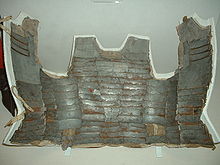Brigantine (armor)
A brigantine was a type of scale armor that had been in use since the 14th century and was formed from the lentner , a late form of the plate skirt .
description
The brigantine consisted of numerous metal plates, often tinned for protection, which were riveted under a layer of fabric, strong linen or even velvet. The rivet heads that were visible on the outside of the outer fabric form the typical look of the brigantine. Often these rivet heads were arranged and decorated in groups of three. Since the plates were held in different sizes and riveted in different directions, the brigantine guaranteed a good combination of mobility and protection - not as rigid, but less protection than plate armor , but also not as permeable (but more immobile) as chain mail .
Making a brigantine was easier and required less expertise than making plate armor. Because of the cost factor, among other things, it was often worn by simpler soldiers from the 15th century. However, brigantines were also used by the wealthy classes. These expensive specimens were often covered with a valuable fabric made of silk, velvet or brocade and the visible rivet heads were gilded.
A later form of the brigantine is the English Jack of Plates, a quilted doublet that also had sewn-in metal plates.
literature
- Auguste Demmin : The historical development of war weapons from the Stone Age to the invention of the needle gun. A handbook of armory. Seemann, Leipzig 1869.
- Konrad Spindler and Harald Stadler (eds.): The Brigantine Symposium at Tirol Castle , Meran 2004, ISBN 88-901142-3-1
Individual evidence
- ↑ Konrad Spindler and Harald Stadler (eds.): The Brigantine Symposium at Tirol Castle , Meran 2004, ISBN 88-901142-3-1 , page 211
- ↑ Konrad Spindler and Harald Stadler (eds.): The Brigantine Symposium at Tirol Castle , Meran 2004, ISBN 88-901142-3-1 , page 5


